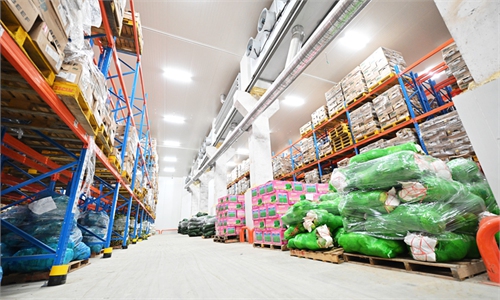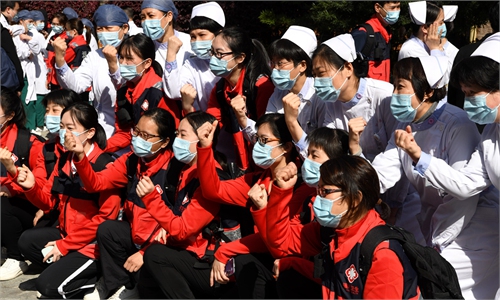Two years after lifting of Wuhan lockdown, national mobilization led by CPC continues to inject confidence in Shanghai’s virus fight

Wuhan. Photo: VCG
Exactly two years ago, the city of Wuhan reemerged from a 76-day lockdown after efforts by medics from across China, volunteers, and ordinary residents successfully brought down the local COVID-19 outbreak. By putting life above everything else and the efficient top-down mobilization, China is rallying the nation again in the fight against Omicron in Shanghai.
Health professionals and residents believe Chinese society has deepened their fundamental understanding of the advantages of China's socialist system in the past two years' battle against the virus, and strengthening the leadership of the Communist Party of China (CPC) will boost confidence in the COVID-19 fight in Shanghai, the birthplace of the CPC.
For the past five days, Cai Shuhan, an ICU doctor from Zhongnan Hospital of Wuhan University, has worked with 50 colleagues in the makeshift hospital in Shanghai New International Expo Center distributing medicine, conducting regular nucleic acid tests, taking care of COVID-19 patients - especially elderly patients with underlying conditions - and transferring those who develop severe symptoms to regular hospitals.
Cai, who in 2020 worked in the ICU in Wuhan's temporary COVID-19 hospital, Leishenshan hospital, said he and his colleagues fought to protect people's lives in Wuhan, as Wuhan's severe case rate was much higher than Shanghai now due to the strong toxicity of the virus in early 2020.
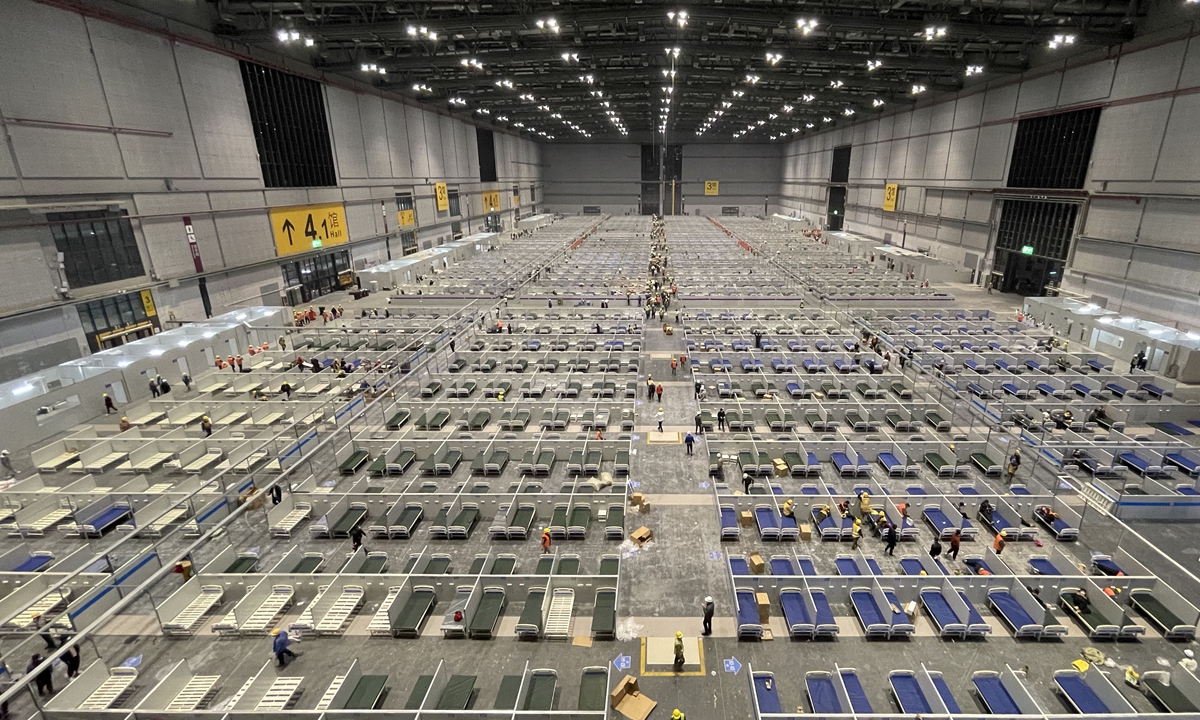
The largest makeshift hospital in Shanghai, renovated from National Convention & Exhibition Center (Shanghai), will be delivered on April 9, 2022 and is expected to provide up to 50,000 beds. Photo: Xinhua
Two years have passed, and the mutation has made the virus more infectious but less toxic, resulting in more people being infected in Shanghai, Cai said, noting that's why Shanghai is building more makeshift hospitals. Makeshift hospitals in Wuhan usually offered around 1,000 to 2,000 beds each, but in Shanghai, one such hospital can offer 15,000 beds.
Cai is one of the 1,237 medics from Hubei Province who arrived in Shanghai this week as one of the 38,000 medical workers from 15 provincial-level regions that have been deployed to aid Shanghai, the largest nationwide medical aid since Wuhan in early 2020.
Dong Haoxu, a doctor from the Tongji Medical College of Huazhong University of Science and Technology in Wuhan, is also working in the shift hospital at the Shanghai New International Expo Center.
To draw lessons from the prevention work in Wuhan, great importance has been attached to preventing infections involving medical staff. Dong told the Global Times that there is a group of working staff to help medical staff take off protection suits and disinfect after a day's work.
Building on the experience of Wuhan and other cities, and as Shanghai finished collecting COVID-19 samples for 25 million people in one day, double the work than in Wuhan, Cai said that "no other country has such a strong capability in mobilizing its residents, and with top-down concerted efforts, we will surely beat the virus."
"When Wuhan entered the unprecedented lockdown in 2020, we were not sure whether we would put the virus under control this way, but I am more confident that we can successfully tame the outbreak in Shanghai," Cai said.
Cai is one of the 1,237 medics from Hubei Province who arrived in Shanghai this week as one of the 38,000 medical workers from 15 provincial-level regions that have been deployed to aid Shanghai, the largest nationwide medical aid since Wuhan in early 2020.
Dong Haoxu, a doctor from the Tongji Medical College of Huazhong University of Science and Technology in Wuhan, is also working in the shift hospital at the Shanghai New International Expo Center.
To draw lessons from the prevention work in Wuhan, great importance has been attached to preventing infections involving medical staff. Dong told the Global Times that there is a group of working staff to help medical staff take off protection suits and disinfect after a day's work.
Building on the experience of Wuhan and other cities, and as Shanghai finished collecting COVID-19 samples for 25 million people in one day, double the work than in Wuhan, Cai said that "no other country has such a strong capability in mobilizing its residents, and with top-down concerted efforts, we will surely beat the virus."
"When Wuhan entered the unprecedented lockdown in 2020, we were not sure whether we would put the virus under control this way, but I am more confident that we can successfully tame the outbreak in Shanghai," Cai said.
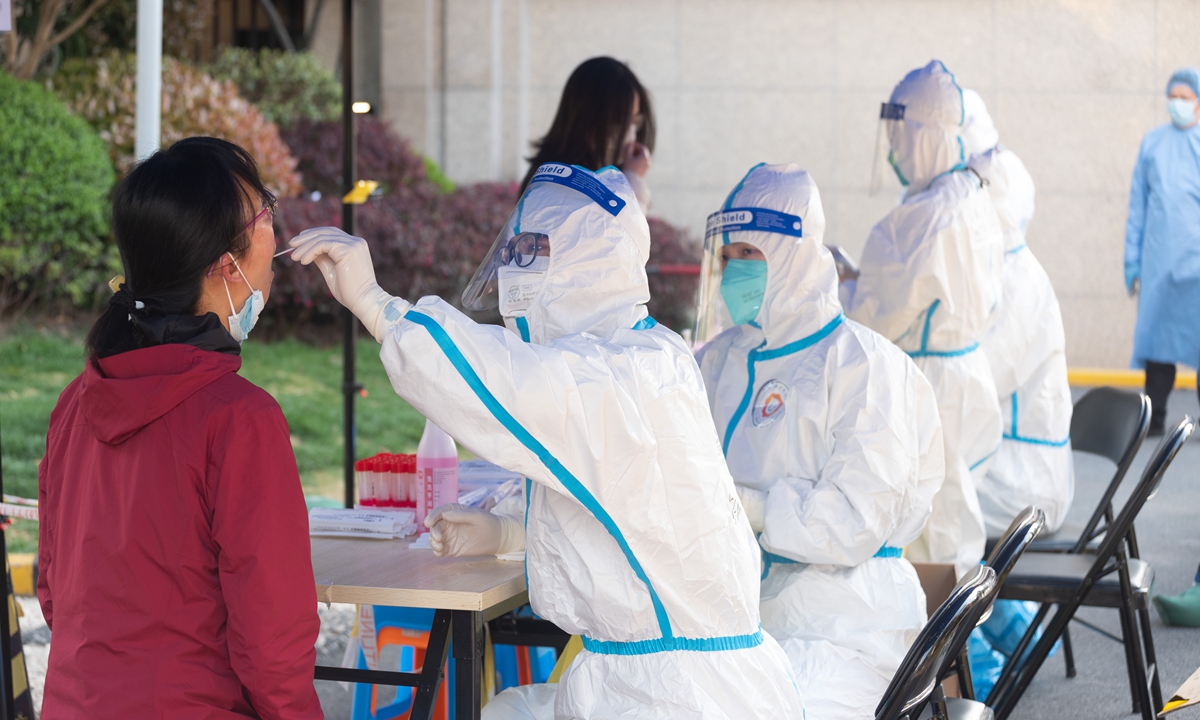
Residents receive COVID-19 nulecic acid test in Shanghai on April 4. Photo: VCG
Racing against Omicron
Shanghai reported on Friday more than 21,222 COVID-19 positive cases, the first time that the daily new cases in the city surpassed 20,000 in this fresh wave.
The Shanghai health commission said at Friday's media briefing that the number of positive cases remains at a high level, indicating the risk of community infections and epidemic control situations.
Shanghai is racing against the virus by delivering more makeshift hospitals and receiving additional help. Shanghai started a new round of citywide antigen testing or nucleic acid testing on Friday, and its biggest makeshift hospital, which can provide 50,000 beds, will be delivered on Saturday.
Several Y-20 planes on Friday arrived in Shanghai Hongqiao Airport, carrying a new batch of PLA medical personnel to aid in the fight against Omicron in Shanghai.
Chinese Vice Premier Sun Chunlan on Thursday night warned that there is no room for slackening off as Shanghai's epidemic situation is arduous, and she urged further optimizing the management at makeshift hospitals, strengthening closed management of communities, and ensuring the supply of medicine and people's life necessities.
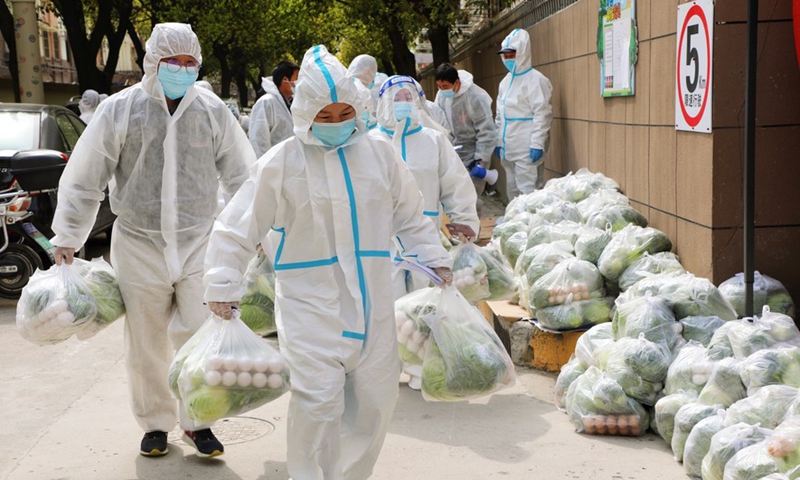
Volunteers carry daily necessities for residents in Fengxian District, east China's Shanghai, March 28, 2022.Photo:Xinhua
While much of Shanghai's communities are in lockdown, residents started to help neighbors by sharing food and volunteering in community epidemic prevention and control.
"Neighbors help each other, and share daily necessities with others in need, such as salt, toothpaste and vegetables," a Shanghai resident surnamed Li told the Global Times on Friday. "The epidemic hits us hard, but brings neighbors closer."
Another resident surnamed Pan from Minhang district, a hard-hit region in Shanghai, told the Global Times that her community has been under lockdown since March 11. They received necessities three times since the home quarantine, including rice, vegetables and meat. "Despite problems due to information that couldn't be released timely to ease residents' concerns, the situation is getting better," Pan said.
For a 28-year-old resident from Xuhui district, who spent around four hours each day delivering goods and helping maintain order in nucleic acid testing, he started to help his neighbors as his community is really short of working staff. He said he wants to help his community tide over this difficulty.
China's e-commerce platforms also stepped in. Alibaba said it is organizing around 3,000 staffers from delivery service platforms and grocery store networks such as Ele.me, Cainiao, Hema Fresh and RT-Mart to help ensure Shanghai residents' daily lives. Other platforms such as Pinduoduo and JD Daojia provide the timely delivery of vegetable, fruits and daily necessaries.
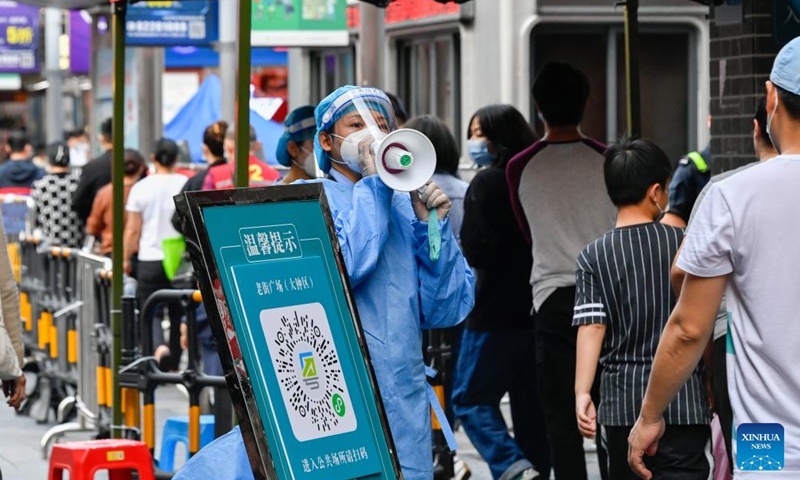
A volunteer in protective gear guides citizens at a nucleic acid testing site in Luohu District of Shenzhen, south China's Guangdong Province, March 13, 2022.Photo:Xinhua
Battle led by CPC
Since March, several cities with over 10 million residents were hit by the latest wave, but most are slowly recovering. Chinese health professionals said success in cities like Shenzhen and Jilin has greatly boosted the nation's confidence in stemming the spread of the virus in Shanghai.
After a 37-day battle against COVID-19, Northeast China's Jilin Province announced on Friday that Jilin city, the most affected in the province, has achieved the goal of no community infections.
Shenzhen, China's "Silicon Valley," on Friday started to resume classes in primary and middle schools after a seven-day pause.
All these achievements we made was under the leadership of the CPC, Cai said, noting that history has proven again and again that only the CPC can save China and lead China out of a crisis.
As a Party member, Dong said that the Party committee has played an important role in the prevention work in Wuhan and also in Shanghai.
Party flags were hung on the working areas in the hospital where Dong worked. "Every time we walked past the flag, we felt proud and the flag also reminds us to take the lead in fighting the virus," said Dong, noting that many of his colleagues also took pictures of themselves with the Party flag.
After deeply witnessing the CPC's strength, 13 medical workers from Cai's hospital applied to join the Party.
As secretary of a temporary Party unit of the hospital in Shanghai, Cai said they organized the first Party meeting the day after they arrived in Shanghai, and they are ready to offer help where they are needed even after the outbreak.
In a letter sent to all CPC members in Shanghai on Wednesday, the CPC Shanghai Municipal Committee said that Shanghai is the birthplace of the CPC, and generations of CPC members have never been afraid of any risk or challenge.
We believe with the firm leadership of the CPC, the people's help, and effort of a large number of CPC members, no difficulty would crush the heroic Shanghai residents, the letter said.
